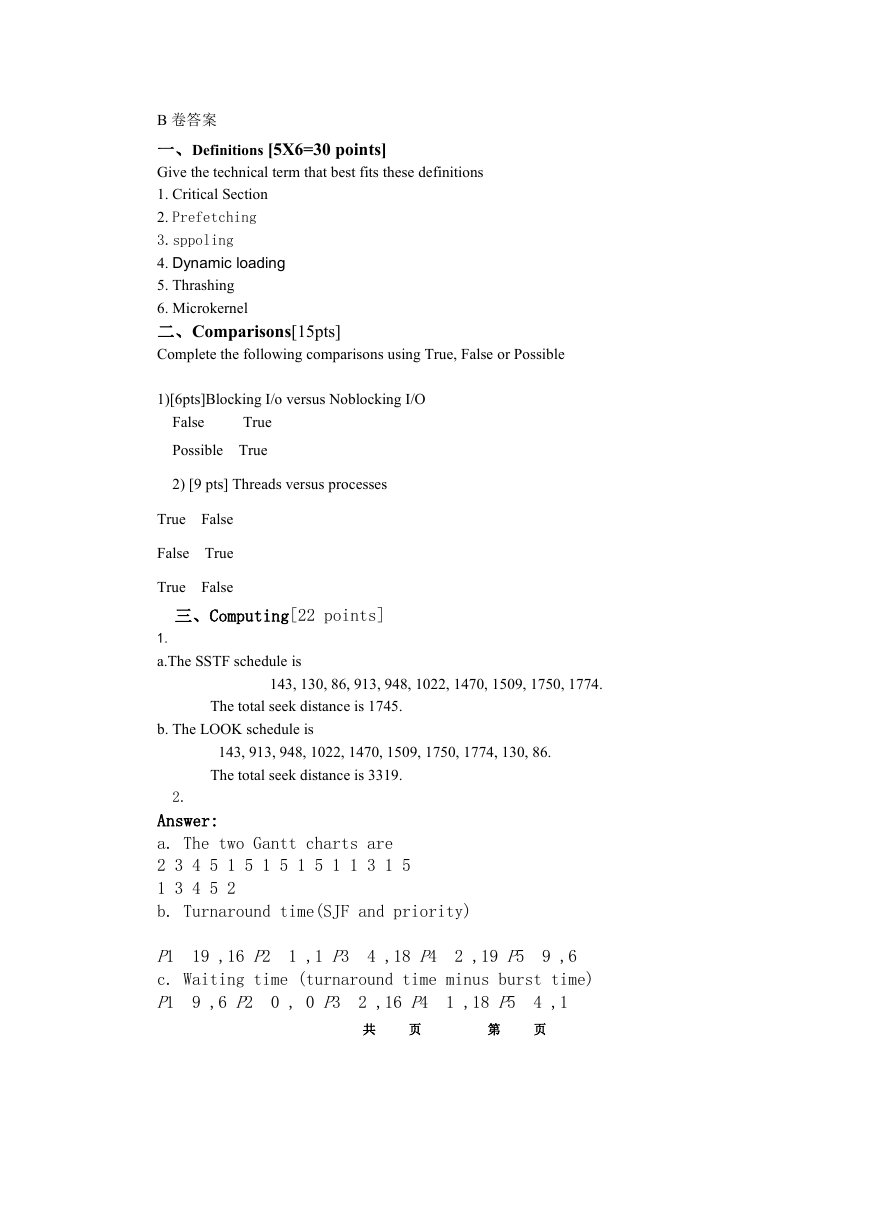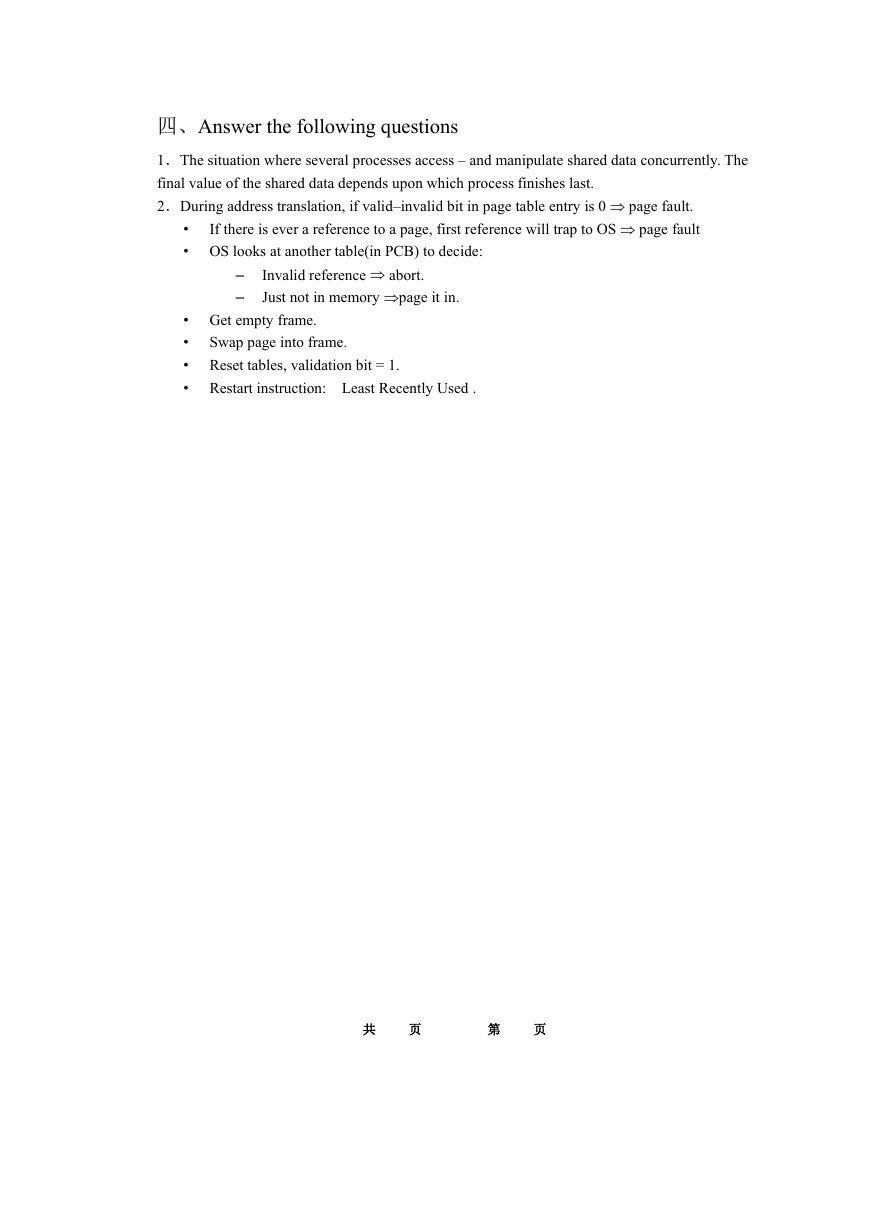东 南 大 学 考 试 卷 ( B 卷)
课 程 名 称
操作系统
考 试 学 期 0 7 - 0 8 - 2
得分
适 用 专 业
计算机应用
考 试 形 式
闭卷
考 试 时 间 长 度 120 分钟
一、Definitions [5X6=30 pts]
Give the technical term that best fits these definitions
1. Portion of a program that accesses shared variables and that no two processes can
be executing this code that manipulates shared variables at the same time.
2. It is a method of overlapping the I/O of a job with that job’s own computation.
The idea is simple. After a read operation completes and the job is about to start
operating on the data, the input device is instructed to begin the next read
immediately. The CPU and input device are then both busy.
3. Some devices, such as tape drives and printers, cannot usefully multiplex the I/0
requests of multiple concurrent applications. The subsystems can coordinate
concurrent output to a separate disk file. For instance, When an application finishes
printing, the subsystem copies the queued files to the printer one, at a time.
4. Unused routine is never loaded.
5. A process is busy swapping pages in and out.
6. A small operating system core that provides basic scheduling, memory
management and communication services while relying on processes to perform
the other required functionality traditionally associated with the operating system.
自
觉
遵
守
考
场
纪
律
如
考
试
作
弊
此
答
卷
无
效
线
封
密
名
姓
号
学
共
页
第
页
�
二、Comparisons[6+9=15pts]
Complete the following comparisons using True, False or Possible
1.[6pts]Blocking I/o versus Noblocking I/O
Blocking I/O
Noblocking I/O
Point of Comparison
I/O call returns
as much as available
Implemented via
multi-threading
2. [9 pts] Threads versus processes
Point of Comparison
Threads
Processes
Share all global variables
Execute in separate address spaces
Require less time to create, terminate
and switch from one to another
三、Computing[10+12=22 pts]
1.Suppose that a disk drive has 5000 cylinders, numbered 0 to 4999. The drive is
currently serving a request at cylinder 143, and the previous request was at cylinder
125. The queue of pending requests, in FIFO order, is
86, 1470, 913, 1774, 948, 1509, 1022, 1750, 130
Starting from the current head position, what is the total distance (in cylinders) that
the disk arm moves to satisfy all the pending requests, for each of the following
disk-scheduling algorithms? [10 pts]
a. SSTF
b. LOOK
2. Consider the following set of processes, with the length of the
CPU-burst time given in milliseconds:
Process Burst Time Priority
共
页
第
页
�
P1
P2
P3
P4
P5
10
1
2
1
5
3
1
3
4
2
The processes are assumed to have arrived in the order P1, P2, P3, P4,
P5, all at time 0. [12 pts]
a. Draw the Gantt chart illustrating the execution of these processes
using SJF, a nonpreemptive priority (a smaller priority number implies
a higher priority) scheduling.
b. What is the turnaround time of each process for the scheduling
algorithm in part a?
c. What is the waiting time of each process for the scheduling algorithm
in part a?
四、Answer the following questions [8+10=18 pts]
1.What is a race condition? When does it happen? [8pts]
2. Under what circumstances do page faults occur ? Describe the actions taken by
the operating system when a page fault occurs. [10pts]
五、Programming[15 pts]
The Sleeping-Barber Problem. A barbershop consists of a waiting room with n
chairs, and a barber room with one barber chair.
If there are no customers to be
If a customer enters the barbershop and all chairs
served, the barber goes to sleep.
If the barber is busy, but chairs
are occupied, then the customer leaves the shop.
are available, then the customer sits in one of the free chairs.
If the barber is
asleep, the customer wakes up the barber. Write a program to coordinate the barber
and the customers using Java synchronization ( or vc++ with P and V
operations).
共
页
第
页
�
B 卷答案
一、Definitions [5X6=30 points]
Give the technical term that best fits these definitions
1. Critical Section
2. Prefetching
3.sppoling
4. Dynamic loading
5. Thrashing
6. Microkernel
二、Comparisons[15pts]
Complete the following comparisons using True, False or Possible
1)[6pts]Blocking I/o versus Noblocking I/O
False
True
Possible True
2) [9 pts] Threads versus processes
True False
False True
True False
三、Computing[22 points]
1.
a.The SSTF schedule is
143, 130, 86, 913, 948, 1022, 1470, 1509, 1750, 1774.
The total seek distance is 1745.
b. The LOOK schedule is
143, 913, 948, 1022, 1470, 1509, 1750, 1774, 130, 86.
The total seek distance is 3319.
2.
Answer:
a. The two Gantt charts are
2 3 4 5 1 5 1 5 1 5 1 1 3 1 5
1 3 4 5 2
b. Turnaround time(SJF and priority)
1 ,1 P3 4 ,18 P4
P1 19 ,16 P2
c. Waiting time (turnaround time minus burst time)
P1 9 ,6 P2
2 ,19 P5
0 , 0 P3
2 ,16 P4
9 ,6
1 ,18 P5
4 ,1
共
页
第
页
�
四、Answer the following questions
1.The situation where several processes access – and manipulate shared data concurrently. The
final value of the shared data depends upon which process finishes last.
2.During address translation, if valid–invalid bit in page table entry is 0 page fault.
If there is ever a reference to a page, first reference will trap to OS page fault
•
• OS looks at another table(in PCB) to decide:
–
–
Invalid reference abort.
Just not in memory page it in.
• Get empty frame.
•
•
•
Swap page into frame.
Reset tables, validation bit = 1.
Restart instruction: Least Recently Used .
共
页
第
页
�
共
页
第
页
�












 2023年江西萍乡中考道德与法治真题及答案.doc
2023年江西萍乡中考道德与法治真题及答案.doc 2012年重庆南川中考生物真题及答案.doc
2012年重庆南川中考生物真题及答案.doc 2013年江西师范大学地理学综合及文艺理论基础考研真题.doc
2013年江西师范大学地理学综合及文艺理论基础考研真题.doc 2020年四川甘孜小升初语文真题及答案I卷.doc
2020年四川甘孜小升初语文真题及答案I卷.doc 2020年注册岩土工程师专业基础考试真题及答案.doc
2020年注册岩土工程师专业基础考试真题及答案.doc 2023-2024学年福建省厦门市九年级上学期数学月考试题及答案.doc
2023-2024学年福建省厦门市九年级上学期数学月考试题及答案.doc 2021-2022学年辽宁省沈阳市大东区九年级上学期语文期末试题及答案.doc
2021-2022学年辽宁省沈阳市大东区九年级上学期语文期末试题及答案.doc 2022-2023学年北京东城区初三第一学期物理期末试卷及答案.doc
2022-2023学年北京东城区初三第一学期物理期末试卷及答案.doc 2018上半年江西教师资格初中地理学科知识与教学能力真题及答案.doc
2018上半年江西教师资格初中地理学科知识与教学能力真题及答案.doc 2012年河北国家公务员申论考试真题及答案-省级.doc
2012年河北国家公务员申论考试真题及答案-省级.doc 2020-2021学年江苏省扬州市江都区邵樊片九年级上学期数学第一次质量检测试题及答案.doc
2020-2021学年江苏省扬州市江都区邵樊片九年级上学期数学第一次质量检测试题及答案.doc 2022下半年黑龙江教师资格证中学综合素质真题及答案.doc
2022下半年黑龙江教师资格证中学综合素质真题及答案.doc